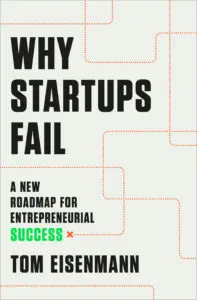How fast is too fast? Fab.com cofounder and CEO Jason Goldberg learned the hard way. When it launched in 2011, Fab was a flash-sale site that curated distinctively designed consumer products and sold them at deeply discounted prices. It was an instant hit. Fab’s featured offers spread like wildfire through social media, so Fab didn’t have to spend any money on marketing—initially. The products were shipped directly to consumers by their designers, so Fab didn’t hold any inventory—initially. As a result, the fledgling venture had positive cash flow—temporarily.
To prepare for further growth, Fab raised $320 million in venture capital. It sold an impressive $115 million of merchandise during 2012—but its business model was starting to unravel. To sustain its growth, Fab spent $40 million on marketing that year, and lost $90 million. Shoppers attracted through ads were less obsessed with design than Fab’s early customers, and as a result were much less likely to purchase multiple times from Fab or spread word of its offers. In late 2012, Goldberg, realizing that he could not build an e-commerce giant on flash sales alone, announced a pivot. Now, Fab would hold merchandise in inventory and ship goods from its own warehouses. The company would also design and sell Fab-branded products. These moves, which consumed a great deal of capital, were controversial. Some observers were perplexed, arguing that flash sales still had momentum; others, however, had faith in Goldberg’s instincts.
The coup de grâce for Fab was its headlong expansion into Europe. Fab had been cloned there by the Samwer brothers, who routinely copied successful U.S. websites—like Pinterest, Airbnb, and Zappos—and then demanded that the U.S. company acquire the knockoff to avoid trench warfare. Goldberg was furious and refused to roll over: He launched Fab across Europe. The Samwers eventually shuttered their clone, but Fab’s victory was Pyrrhic. After burning through the vast majority of its capital, Fab was sold in late 2014 for only $30 million—having once been valued by its VCs at more than $1 billion.
Rapid rise; rapid fall. By expanding at an unsustainable pace, new ventures—including both venture capital-backed startups like Fab and new businesses launched by big, established companies—can fall prey to what I call a speed trap. Speed traps are one of six patterns behind the demise of new ventures I write about in my book, Why Startups Fail: A New Roadmap for Entrepreneurial Success.
Here’s how a speed trap unfolds:
Step 1: Opportunity Spotted. An entrepreneur identifies a novel solution to strong, unmet customer needs. Fab’s curated products; Groupon’s deals, Birchbox’s beauty product samples, and Blue Apron’s meal kits are examples.
Step 2: Strong Early Growth. Rapid expansion is fueled by word-of-mouth referrals from excited early adopters.
Step 3: Fundraising Success. Topsy-turvy growth attracts investors who enthusiastically commit capital, expecting continued expansion. By selling investors a dazzling vision, a charismatic founder—like Fab’s Jason Goldberg or WeWork’s Adam Neumann—can stoke ambitions for hypergrowth.
Step 4: Rivals Enter. Growth attracts rivals. Some are copycats, like Fab’s clones. Others could be “sleeping dragons”—industry incumbents who, loathe to cede market share, counterattack. Rivals cut prices and boost marketing outlays to gain share.
Step 5: Saturation. Meanwhile, the new venture begins to saturate the pool of infatuated early adopters. To attract the next wave of customers, who are less interested in the venture’s offering, they must advertise heavily. As the average cost to acquire a customer is rising, the lifetime value of a typical new customer is declining, because these new buyers are less loyal and less inclined to repurchase. At some point, new customers are worth less than the marketing investment necessary to attract them. If investors value growth over profitability, they may be willing to pump more money into the company—but not indefinitely.
Step 6: Staffing Bottlenecks. To support expansion, many rapidly scaling startups must hire legions of new employees. Finding qualified candidates and training them quickly can be challenging. Competent workers will be in short supply, and as a result, customers’ emails will go unanswered, as recently seen at the online stock brokerage Robinhood, about which the Federal Trade Commission received 650 customer complaints in 2020—more than twice the level of larger rivals like Ameritrade or Fidelity. Likewise, products won’t be inspected before they are sold, shipments will contain the wrong items, and so forth. Such problems can be costly to correct and can boost customer churn.
Step 7: Specialists and Systems Needed. Coordinating a larger workforce requires: 1) senior specialists in marketing, operations, and other functions, and 2) new information systems and formalized processes for planning and monitoring performance. Bringing management talent and new systems on board while scrambling to fill orders is a tall order. Coordinating the efforts of a larger workforce requires formalized organizational processes, but entrepreneurs often resist what they see as burgeoning bureaucracy. With too little structure, a scaling startup can spin out of control.
Step 8: Internal Discord. Rapid growth in head count also can lead to conflict, morale problems, and the dissipation of the company’s culture. For example, sales complains about the quality of the leads that marketing provided while marketing complains that engineering is late with promised new features. Finger-pointing elicits “it’s not my fault” responses and provokes ire. “Old guard/new guard” tensions also flare as veterans resent the “just a job” attitude of newcomers. Meanwhile, newly hired specialists are frustrated that early team members are clueless about their contributions. Senior management tries to tamp down organizational fires and rally the troops, but middle managers start to wonder if senior management really knows what’s going on
Step 9: Ethical Lapses. Sometimes, the relentless pressure to sustain growth leads entrepreneurs to cut legal, regulatory, or ethical corners. Uber, for example, was accused of encouraging its employees to book and then cancel rides with its rival, Lyft. Zenefits, a licensed health insurance broker, created software that allegedly allowed its salespeople to cheat on state licensing exams to sustain the startup’s rapid growth.
Step 10: Investor Alarm. As the venture burns through its capital, investors become reluctant to commit more. Moreover, if an existing investor is willing to throw the startup a lifeline, they’ll demand a huge number of new shares, massively diluting the equity stakes of senior managers and any investors who don’t follow suit. Since the board has to approve such a financing, knock-down, drag-out boardroom fights over whether and how to proceed can ensue.
Step 11: Endgame. At this point, the problem is clear: The company is growing at an unsustainable rate and must slow down. The question is, how hard to slam on the brakes? Is it enough to turn down the marketing spigot? Or, does the startup need to cut head count to survive? Does it make sense to try to sell the company? If investors won’t provide the capital required to turn the company around, will a corporation with deep pockets see a strategic fit?
Speed trap victims may bypass some of the steps above. Fab, for example, did not suffer severe customer service problems due to staffing bottlenecks, nor was its management guilty of ethical lapses. But when new ventures scale too quickly, they’re at risk for falling into many of the speed trap’s stages, and dire consequences can follow. Some survive by trimming head count, cutting marketing, and refocusing on more loyal and profitable customer segments. Birchbox, Blue Apron, Groupon, Zenefits, and Zynga are examples. However, for many other startups—like Fab, along with Ample Hills, MoviePass, Munchery, Nasty Gal, Shyp, and uBiome—the speed trap is fatal.
How to avoid or safely pass through a speed trap? Put simply, you need to know and follow the speed limit. An entrepreneur should ask two sets of questions before stepping on the gas.
First, is the venture really ready to scale? Specifically, does it have product-market fit—that is, does its product meet the market’s needs—and a clear path to profitability? Can the venture sustain product-market fit as it grows? Is its target market big enough to support expansion? Does the venture have a high enough profit margin to withstand a price/cost squeeze as rivals enter and new customers become harder to attract?
Second, will the venture be able to scale? In particular, can the venture access the human and capital resources required to expand rapidly? Can it hire and train large numbers of new workers? And, to coordinate their efforts, can it recruit the right specialist managers? Will the capital markets be open for business when the company needs to fund further expansion? This is a real threat: Entire industry sectors can experience sudden and prolonged downdrafts in investor sentiment, as with clean tech starting in 2011. During a funding dry spell, even healthy companies may struggle to raise capital.
The biggest risk to entrepreneurs confronting a speed trap is their own mindset. Founders love growth: It’s how many of them keep score. Growth is a magnet for talent and investment. And the business model of venture capital firms—reaping huge rewards from only a small fraction of their portfolio companies while realizing breakeven returns or losses on the rest—amplifies the pressure on founders to grow at full tilt. Finally, entrepreneurs are prone to overconfidence. It can be an asset when they are pitching, and it can power them through tough times. But overconfidence can also blind entrepreneurs to risks of rapid expansion. They should remember: Not every company is destined to be a fast company.

This essay was adapted from the book Why Startups Fail: A New Roadmap for Entrepreneurial Success by Tom Eisenmann. Copyright © 2021 by Tom Eisenmann. Used by permission of Currency Books, an imprint of Random House, a division of Penguin Random House LLC. All rights reserved.
Recognize your brand’s excellence by applying to this year’s Brands That Matter Awards before the early-rate deadline, May 3.
